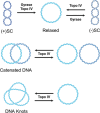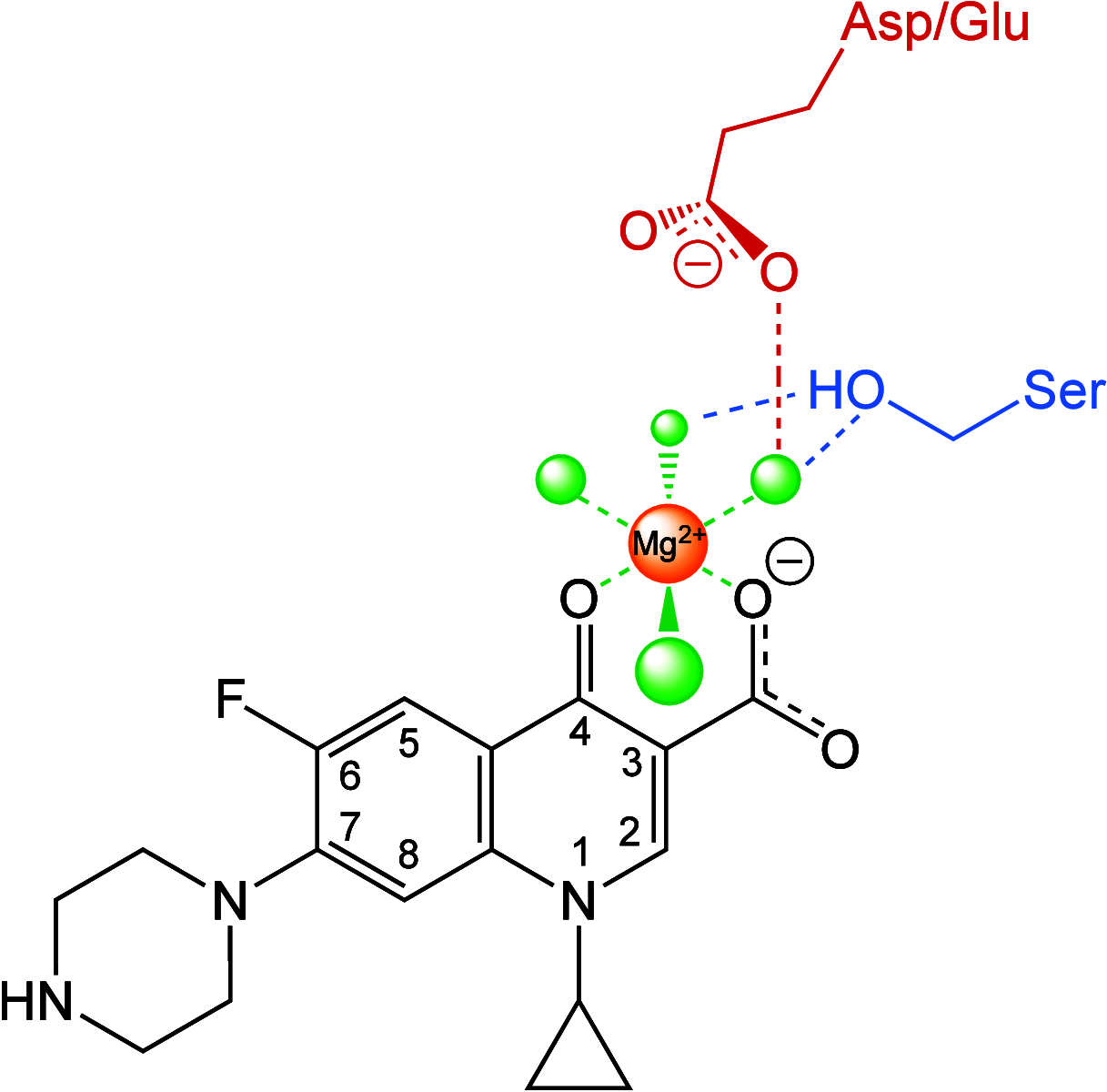Gyrase and Topoisomerase IV: Recycling Old Targets for New Antibacterials to Combat Fluoroquinolone Resistance
- PMID: 38564341
- PMCID: PMC11019561
- DOI: 10.1021/acsinfecdis.4c00128
Gyrase and Topoisomerase IV: Recycling Old Targets for New Antibacterials to Combat Fluoroquinolone Resistance
Abstract
Beyond their requisite functions in many critical DNA processes, the bacterial type II topoisomerases, gyrase and topoisomerase IV, are the targets of fluoroquinolone antibacterials. These drugs act by stabilizing gyrase/topoisomerase IV-generated DNA strand breaks and by robbing the cell of the catalytic activities of these essential enzymes. Since their clinical approval in the mid-1980s, fluoroquinolones have been used to treat a broad spectrum of infectious diseases and are listed among the five "highest priority" critically important antimicrobial classes by the World Health Organization. Unfortunately, the widespread use of fluoroquinolones has been accompanied by a rise in target-mediated resistance caused by specific mutations in gyrase and topoisomerase IV, which has curtailed the medical efficacy of this drug class. As a result, efforts are underway to identify novel antibacterials that target the bacterial type II topoisomerases. Several new classes of gyrase/topoisomerase IV-targeted antibacterials have emerged, including novel bacterial topoisomerase inhibitors, Mycobacterium tuberculosis gyrase inhibitors, triazaacenaphthylenes, spiropyrimidinetriones, and thiophenes. Phase III clinical trials that utilized two members of these classes, gepotidacin (triazaacenaphthylene) and zoliflodacin (spiropyrimidinetrione), have been completed with positive outcomes, underscoring the potential of these compounds to become the first new classes of antibacterials introduced into the clinic in decades. Because gyrase and topoisomerase IV are validated targets for established and emerging antibacterials, this review will describe the catalytic mechanism and cellular activities of the bacterial type II topoisomerases, their interactions with fluoroquinolones, the mechanism of target-mediated fluoroquinolone resistance, and the actions of novel antibacterials against wild-type and fluoroquinolone-resistant gyrase and topoisomerase IV.
Keywords: fluoroquinolone resistance; gyrase; novel bacterial topoisomerase inhibitors; spiropyrimidinetriones; topoisomerase IV; triazaacenaphthylenes.
Conflict of interest statement
The authors declare no competing financial interest.
Figures









Similar articles
-
Interactions between Zoliflodacin and Neisseria gonorrhoeae Gyrase and Topoisomerase IV: Enzymological Basis for Cellular Targeting.ACS Infect Dis. 2024 Aug 9;10(8):3071-3082. doi: 10.1021/acsinfecdis.4c00438. Epub 2024 Jul 31. ACS Infect Dis. 2024. PMID: 39082980 Free PMC article.
-
A Series of Spiropyrimidinetriones that Enhances DNA Cleavage Mediated by Mycobacterium tuberculosis Gyrase.ACS Infect Dis. 2023 Mar 10;9(3):706-715. doi: 10.1021/acsinfecdis.3c00012. Epub 2023 Feb 20. ACS Infect Dis. 2023. PMID: 36802491 Free PMC article.
-
Target-Mediated Fluoroquinolone Resistance in Neisseria gonorrhoeae: Actions of Ciprofloxacin against Gyrase and Topoisomerase IV.ACS Infect Dis. 2024 Apr 12;10(4):1351-1360. doi: 10.1021/acsinfecdis.4c00041. Epub 2024 Mar 4. ACS Infect Dis. 2024. PMID: 38606464 Free PMC article.
-
Targeting DNA Gyrase to Combat Mycobacterium tuberculosis: An Update.Curr Top Med Chem. 2019;19(8):579-593. doi: 10.2174/1568026619666190304130218. Curr Top Med Chem. 2019. PMID: 30834837 Review.
-
DNA topoisomerase I and DNA gyrase as targets for TB therapy.Drug Discov Today. 2017 Mar;22(3):510-518. doi: 10.1016/j.drudis.2016.11.006. Epub 2016 Nov 14. Drug Discov Today. 2017. PMID: 27856347 Review.
Cited by
-
The SWIB domain-containing DNA topoisomerase I of Chlamydia trachomatis mediates DNA relaxation.bioRxiv [Preprint]. 2024 Dec 3:2024.12.03.626651. doi: 10.1101/2024.12.03.626651. bioRxiv. 2024. Update in: J Bacteriol. 2025 Aug 12:e0019025. doi: 10.1128/jb.00190-25. PMID: 39677648 Free PMC article. Updated. Preprint.
-
PARP1-driven repair of topoisomerase IIIα DNA-protein crosslinks by FEN1.Cell Rep. 2024 Aug 27;43(8):114522. doi: 10.1016/j.celrep.2024.114522. Epub 2024 Jul 18. Cell Rep. 2024. PMID: 39028621 Free PMC article.
-
Towards catalytic fluoroquinolones: from metal-catalyzed to metal-free DNA cleavage.RSC Med Chem. 2025 Mar 5;16(6):2576-2591. doi: 10.1039/d4md00984c. eCollection 2025 Jun 18. RSC Med Chem. 2025. PMID: 40162203 Free PMC article.
-
Antibiotics Resistance Profile of Clinical Isolates of Pseudomonas aeruginosa Obtained from Farwaniya Hospital in Kuwait Using Phenotypic and Molecular Methods.Antibiotics (Basel). 2025 May 24;14(6):539. doi: 10.3390/antibiotics14060539. Antibiotics (Basel). 2025. PMID: 40558129 Free PMC article.
-
Role of DNA Double-Strand Break Formation in Gyrase Inhibitor-Mediated Killing of Nonreplicating Persistent Mycobacterium tuberculosis in Caseum.ACS Infect Dis. 2024 Oct 11;10(10):3631-3639. doi: 10.1021/acsinfecdis.4c00499. Epub 2024 Sep 24. ACS Infect Dis. 2024. PMID: 39315541 Free PMC article.
References
-
- Gibson E. G.; Ashley R. E.; Kerns R. J.; Osheroff N.. Fluoroquinolone interactions with bacterial type II topoisomerases and target-mediated drug resistance. In Antimicrobial Resistance in the 21st Century, 2nd ed.; Drlica K., Shlaes D., Fong I. W., Eds.; Springer Nature, 2018; pp 507–529.
-
- Hiasa H.DNA topoisomerases as targets for antibacterial agents. In DNA Topoisomerases, Drolet M., Ed.; Methods in Molecular Biology, Vol. 1703; Humana Press, 2018; pp 47–62. - PubMed
Publication types
MeSH terms
Substances
Grants and funding
LinkOut - more resources
Full Text Sources
Research Materials

